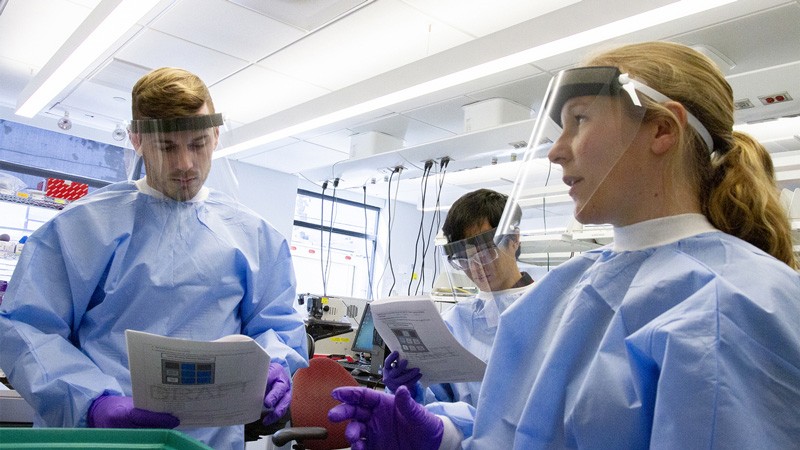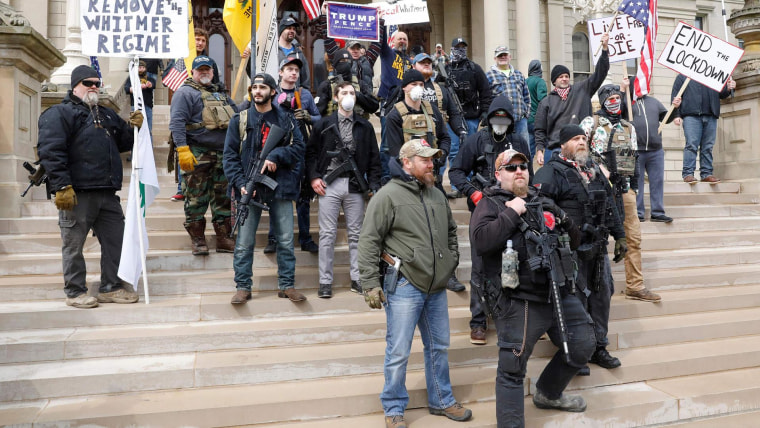The coronavirus
Comments
-
Colorado will be loosening up soon, too. Hopefully news outlets will start reporting by region instead of constantly presenting "US" numbers. Some parts of the country are in a better position to do this than others. My fear is that people in hotter spots will see this and start getting antsy, even though they're in a much more precarious spot.
https://www.cpr.org/2020/04/20/as-colorado-stay-at-home-order-nears-end-gov-polis-outlines-new-phase-of-coronavirus-marathon/
0 -
So far it’s just all kittens and rainbows and flowers, but no data. Aren’t they obligated to publish this stuff?pjl44 said:
The directions, too. Hopefully it's not just a gif of The Joker's pencil trick.oftenreading said:
I want to see their data. I’m not sure I’ll have time today to look for it but I’ll try.pjl44 said:
I wondered about that, too. But LabCorp is legit so I imagine/think/hope they know what they're doing.oftenreading said:pjl44 said:
Interesting. I would like to see their validity data. It's not easy to do a nasopharyngeal swab on yourself. Done correctly, it's a painful procedure, and done incorrectly you won't get a useful sample. I would be concerned about a high rate of false negatives with this.Some positive news: LabCorp granted emergency use authorization for at-home tests. Will initially be made available to healthcare workers and first responders and "in the coming weeks" to consumers.
@brianlux, I regret to inform you that it is a nasal swab.
https://www.businesswire.com/news/home/20200421005452/en/LabCorp-COVID-19-At-Home-Test-Kit-Receives-FDAI have learned that the at home test is only a nasal swab, not nasopharyngeal, because the NP swab is “too uncomfortable”. What that change does to accuracy, they don’t say.my small self... like a book amongst the many on a shelf0 -
I guess we just have to trust the FDA thumbs up? Maybe you have to look at it similarly to Rx vs OTC drugs. Rx comes with a PI where you can see efficacy data. That same drug goes OTC and it's just directions for use, contraindications, etc. Unless they want to tout the accuracy (like pregnancy tests), do at-home tests generally publish that data publicly?oftenreading said:
So far it’s just all kittens and rainbows and flowers, but no data. Aren’t they obligated to publish this stuff?pjl44 said:
The directions, too. Hopefully it's not just a gif of The Joker's pencil trick.oftenreading said:
I want to see their data. I’m not sure I’ll have time today to look for it but I’ll try.pjl44 said:
I wondered about that, too. But LabCorp is legit so I imagine/think/hope they know what they're doing.oftenreading said:pjl44 said:
Interesting. I would like to see their validity data. It's not easy to do a nasopharyngeal swab on yourself. Done correctly, it's a painful procedure, and done incorrectly you won't get a useful sample. I would be concerned about a high rate of false negatives with this.Some positive news: LabCorp granted emergency use authorization for at-home tests. Will initially be made available to healthcare workers and first responders and "in the coming weeks" to consumers.
@brianlux, I regret to inform you that it is a nasal swab.
https://www.businesswire.com/news/home/20200421005452/en/LabCorp-COVID-19-At-Home-Test-Kit-Receives-FDAI have learned that the at home test is only a nasal swab, not nasopharyngeal, because the NP swab is “too uncomfortable”. What that change does to accuracy, they don’t say.0 -
How long are some of you willing to be locked down for? As long as it takes?Give Peas A Chance…0
-
mace1229 said:
I, nor anyone else on here that I saw, ever suggested business as usual. So no, this picture does not help.CM189191 said:mace1229 said:CM189191 said:mace1229 said:
So I see instead of trying to explain why if you’re worried about sheer numbers of people on a boat it doesn’t make sense to limit boat capacity and instead just ban certain types of boats that may or may not have a large capacity while allowing other boats that also may or may not have a large capacity and instead just say I don’t understand.CM189191 said:
You're talking about anecdotal evidence, when the law of large numbers applies.mace1229 said:
I’m not buying any of that (except maybe the wondering Home Depot, but then ban all non essential sales). But then be uniform with that decision, make Costco bam all non essential sales too, and not just Home Depot and gardening. It’s like trying to solve the gun problem by banning all Colts and doing nothing else. Makes no sense.CM189191 said:
Minnesota told people not to visit their summer cabins for a few reasons:mace1229 said:
So it was the doctors who said go line up to buy a lottery ticket, but it’s illegal to listen to a church service in your car?brianlux said:CM189191 said:
Counterpoint: I believe the protesters just want an excuse to shoot somebody. While governors are relying on actual experts scientists and professional opinion.mace1229 said:
That second hump is exactly aligned with the flu season, so I’m not convinced the interventions had much to do with it or not.CM189191 said:
And I believe most protesters just want common sense measure. Not just blindly and willy nilly deciding what people can and can’t do, which several governors seem to have taken as their approach.Yeah, I'll believe these people... ...over these any day:
...over these any day: The problem is those doctors in that picture aren’t making the decions, and many of the decisions ate not based off any medical or professional advice.
The problem is those doctors in that picture aren’t making the decions, and many of the decisions ate not based off any medical or professional advice.
Some states have restricted lake access to lakeside homes while others allow it as long as its a powerless boat. That to me makes no sense. Michigan has essentially banned all gardening sales and forced stores to block off gardening isles while much of the store still sells non essential items. 90% of Costco isn’t essential, why target gardening and not liquor and lottery sales?
And that’s the problem, doctors have made none of those decisions. It’s governors or other local officials and much of it makes no sense as to what you can and can’t do or buy. Some governors have gone way overboard.- travel spreads CV19
- people who own cabin homes are disproportionately older demographic
- rural areas are less likely to follow social distancing guidelines because apparently CV19 is 'an urban problem'
- rural hospitals have less resources and will be easily overwhelmed
Liquor & lottery is essential because can you imagine what will happen to community health if all the gambling addicts and alcoholics can't suddenly get booze or scratchers? (hint: it's not good)
Gardening hasn't been targeted. People can still shop online for pickup or delivery. These are bored old folks who just want to spend hours wandering their local Home Depot (infecting other old folks).
Powerless boats were omitted because kayaks, canoes and sailboats hold less people. Would you rather all boats were restricted?
These things all make sense if you just take a moment to think logically. Or if you listened to the explanations that have clearly been given over and over and over again.
My parents have a second home and it’s just like you described. They are staying there most of the time because it is rural. When they need supplies the local grocery store is stocked, hasn’t run out of toilet paper, no line to get in, etc. their primary home is just outside Sacramento, much higher rate for cases, stores are crowded. Makes so much more sense for them to stay at their second home. They drive to the primary home about once every 2 weeks, drive straight there, bring groceries with them and don’t leave once they get there. But they go to mow the lawn, check on things, etc. I see zero reason to not allow that.
Not all boats are massive power boats. Plenty of motor boats are small 2 or 4 person fishing boats. Plenty of sail boats can hold 10+ people. Instead of banning motor boats if that is the reason then wouldn’t it make more sense to limit boat capacity to 2 people? That’s what I mean by the regulations not making sense. If you’re worried about number of people then limit the number of people, not type of boat.So people with addictions to scratchers get a free pass during this time and everyone else is told to stay home? Not buying that one.I don’t have a problem with liquor stores being open and selling lottery tickets. I do have a problem with the government that allows that also stepping and stopping a church service that several members are listening to via the radio from their car in the parking lot, Parked many feet apart and windows rolled up.I have a problem with a father being arrested for playing catch in an empty park, but because you have an addiction to scratchers you can go ahead and line up in a liquor store. Well I have an addiction to quality time with my kids.
The CV19 virus doesn't care if you 'aren't buying it'.
Or more accurately, don't understand:
It's risk mitigation. Not risk elimination.Or don’t bother to explain why it is bad to allow people to practice their religion from their car during the 2 most important weeks in Christianity and instead say but people will be pissed if you don’t let them line up to buy their weekly lottery and see how they act. Yeah? Are they going to be more pissed than the people already protesting?
I just don’t understand how viruses work.
Gotchya..My dumb ass just thinks it’s more effective to say no more than 2 people on a boat rather than banning some boats and not others and cross my fingers only small groups happen to be allowed.
But anecdotal and I don’t understand.The Department of Natural Resources has gotten many reports about the heavy use of boat launches across the state, and the congregation of people at the launches."In addition, people who use motorized watercraft typically have to procure secondary services for their craft, such as parts and gasoline, that could unnecessarily increase contact with others and spread disease," the DNR said. "The hope is that the prohibition on the use of motorized watercraft will reduce the movement of people within the state and potential contact among people, with the intent of slowing the spread of the coronavirus."
Get it yet?
I think we’ll just have to disagree. I still think there’s a much more effective way. Powerless boats can still use boat launches.
Close boat launches, limit boat capacity, make boat repair shops non essential and that is going to be more effective. People with private lake access or a dock can still enjoy the outdoors which is good for everyone.
My point that got lost in this debate is some governors have pushed their restrictions too far. And boats are just one of dozens of examples if you don’t agree with me about the boat. I don’t think protesting is the right thing to do right now but I can understand why people are upset.
Maybe pictures will help:
There is a lot of area between arresting a dad for playing catch and business as usual.
0 -
Nj has more confirmed cases than China, my family and I are good for as long as it takes.Meltdown99 said:How long are some of you willing to be locked down for? As long as it takes?I'll ride the wave where it takes me......0 -
I wouldn’t describe my experience as being “locked down.” However, I’m anticipating working from home through June and social distancing through May, although there’s talk of a phase one re-opening the second week of May. I don’t know what that consists of, however. Public school distance learning and cancellation of all other school activities is a foregone conclusion. I’m willing to go for as long as it takes until there’s widespread testing and isolation of those infected and until they have a better understanding of all of the potential health affects of the virus. Until then, I’m okay with staying home and limiting my contact to family.Meltdown99 said:How long are some of you willing to be locked down for? As long as it takes?09/15/1998 & 09/16/1998, Mansfield, MA; 08/29/00 08/30/00, Mansfield, MA; 07/02/03, 07/03/03, Mansfield, MA; 09/28/04, 09/29/04, Boston, MA; 09/22/05, Halifax, NS; 05/24/06, 05/25/06, Boston, MA; 07/22/06, 07/23/06, Gorge, WA; 06/27/2008, Hartford; 06/28/08, 06/30/08, Mansfield; 08/18/2009, O2, London, UK; 10/30/09, 10/31/09, Philadelphia, PA; 05/15/10, Hartford, CT; 05/17/10, Boston, MA; 05/20/10, 05/21/10, NY, NY; 06/22/10, Dublin, IRE; 06/23/10, Northern Ireland; 09/03/11, 09/04/11, Alpine Valley, WI; 09/11/11, 09/12/11, Toronto, Ont; 09/14/11, Ottawa, Ont; 09/15/11, Hamilton, Ont; 07/02/2012, Prague, Czech Republic; 07/04/2012 & 07/05/2012, Berlin, Germany; 07/07/2012, Stockholm, Sweden; 09/30/2012, Missoula, MT; 07/16/2013, London, Ont; 07/19/2013, Chicago, IL; 10/15/2013 & 10/16/2013, Worcester, MA; 10/21/2013 & 10/22/2013, Philadelphia, PA; 10/25/2013, Hartford, CT; 11/29/2013, Portland, OR; 11/30/2013, Spokane, WA; 12/04/2013, Vancouver, BC; 12/06/2013, Seattle, WA; 10/03/2014, St. Louis. MO; 10/22/2014, Denver, CO; 10/26/2015, New York, NY; 04/23/2016, New Orleans, LA; 04/28/2016 & 04/29/2016, Philadelphia, PA; 05/01/2016 & 05/02/2016, New York, NY; 05/08/2016, Ottawa, Ont.; 05/10/2016 & 05/12/2016, Toronto, Ont.; 08/05/2016 & 08/07/2016, Boston, MA; 08/20/2016 & 08/22/2016, Chicago, IL; 07/01/2018, Prague, Czech Republic; 07/03/2018, Krakow, Poland; 07/05/2018, Berlin, Germany; 09/02/2018 & 09/04/2018, Boston, MA; 09/08/2022, Toronto, Ont; 09/11/2022, New York, NY; 09/14/2022, Camden, NJ; 09/02/2023, St. Paul, MN; 05/04/2024 & 05/06/2024, Vancouver, BC; 05/10/2024, Portland, OR; 05/03/2025, New Orleans, LA;
Libtardaplorable©. And proud of it.
Brilliantati©0 -
As long as it takes to make sure everyone is safe. I think my boss has realized that I actually work better from home, so I think that will change once this is over. I may only have to go into the office once a week for meetings.Meltdown99 said:How long are some of you willing to be locked down for? As long as it takes?
I obviously want this to be over, but I'd rather let the scientists and doctors do their jobs before rushing out to watch a baseball game or concert. It sucks, but it beats the hell out of the alternative.I LOVE MUSIC.
www.cluthelee.com
www.cluthe.com0 -
I'm going to request to continue working from home. Now that we've proven that it's not only possible but that we absolutely crush it when doing so, I really don't see how they can say no.Halifax2TheMax said:
I wouldn’t describe my experience as being “locked down.” However, I’m anticipating working from home through June and social distancing through May, although there’s talk of a phase one re-opening the second week of May. I don’t know what that consists of, however. Public school distance learning and cancellation of all other school activities is a foregone conclusion. I’m willing to go for as long as it takes until there’s widespread testing and isolation of those infected and until they have a better understanding of all of the potential health affects of the virus. Until then, I’m okay with staying home and limiting my contact to family.Meltdown99 said:How long are some of you willing to be locked down for? As long as it takes?
Other than the homeschooling stuff, which I'm really working on convincing my wife and kids is totally unnecessary (because it is), and being the designated errand runner, life has been awesome for me this past four to six weeks. The best way to live among Massholes is to never have to personally interact with Massholes; even most Massholes will tell you that.I SAW PEARL JAM0 -
I'll be requesting it as well if it isn't presented as an alternative. I actually really enjoy it & I'm a lot more efficient with my time.dankind said:
I'm going to request to continue working from home. Now that we've proven that it's not only possible but that we absolutely crush it when doing so, I really don't see how they can say no.Halifax2TheMax said:
I wouldn’t describe my experience as being “locked down.” However, I’m anticipating working from home through June and social distancing through May, although there’s talk of a phase one re-opening the second week of May. I don’t know what that consists of, however. Public school distance learning and cancellation of all other school activities is a foregone conclusion. I’m willing to go for as long as it takes until there’s widespread testing and isolation of those infected and until they have a better understanding of all of the potential health affects of the virus. Until then, I’m okay with staying home and limiting my contact to family.Meltdown99 said:How long are some of you willing to be locked down for? As long as it takes?
Other than the homeschooling stuff, which I'm really working on convincing my wife and kids is totally unnecessary (because it is), and being the designated errand runner, life has been awesome for me this past four to six weeks. The best way to live among Massholes is to never have to personally interact with Massholes; even most Massholes will tell you that.I LOVE MUSIC.
www.cluthelee.com
www.cluthe.com0 -
Meltdown99 said:How long are some of you willing to be locked down for? As long as it takes?As long as it takes or until I go completely bonkers and jump off the Tallahatchie Bridge.Nahhh, as long as it takes.
"It's a sad and beautiful world"-Roberto Benigni0 -
I've worked from home for 13 years. Getting a kick out of everyone's sudden realization that it's the best thing ever. Cube farms suck.mfc2006 said:
I'll be requesting it as well if it isn't presented as an alternative. I actually really enjoy it & I'm a lot more efficient with my time.dankind said:
I'm going to request to continue working from home. Now that we've proven that it's not only possible but that we absolutely crush it when doing so, I really don't see how they can say no.Halifax2TheMax said:
I wouldn’t describe my experience as being “locked down.” However, I’m anticipating working from home through June and social distancing through May, although there’s talk of a phase one re-opening the second week of May. I don’t know what that consists of, however. Public school distance learning and cancellation of all other school activities is a foregone conclusion. I’m willing to go for as long as it takes until there’s widespread testing and isolation of those infected and until they have a better understanding of all of the potential health affects of the virus. Until then, I’m okay with staying home and limiting my contact to family.Meltdown99 said:How long are some of you willing to be locked down for? As long as it takes?
Other than the homeschooling stuff, which I'm really working on convincing my wife and kids is totally unnecessary (because it is), and being the designated errand runner, life has been awesome for me this past four to six weeks. The best way to live among Massholes is to never have to personally interact with Massholes; even most Massholes will tell you that.0 -
Set a few crawfish traps in the Tallahatchie instead.brianlux said:Meltdown99 said:How long are some of you willing to be locked down for? As long as it takes?As long as it takes or until I go completely bonkers and jump off the Tallahatchie Bridge.Nahhh, as long as it takes. 0
0 -
rgambs said:
look closer at the graph, it's adjusted for normal flu deathsmace1229 said:
That second hump is exactly aligned with the flu season, so I’m not convinced the interventions had much to do with it or not.CM189191 said:
And I believe most protesters just want common sense measure. Not just blindly and willy nilly deciding what people can and can’t do, which several governors seem to have taken as their approach.1918 flu second wave much deadlier than the first.0 -
Swedish meme I translated for you

"Mostly I think that people react sensitively because they know you’ve got a point"0 -
I've worked from home off and on over the last 10 years or so, but it had been a little while since I did it. I had forgotten how much I love it.CM189191 said:
I've worked from home for 13 years. Getting a kick out of everyone's sudden realization that it's the best thing ever. Cube farms suck.mfc2006 said:
I'll be requesting it as well if it isn't presented as an alternative. I actually really enjoy it & I'm a lot more efficient with my time.dankind said:
I'm going to request to continue working from home. Now that we've proven that it's not only possible but that we absolutely crush it when doing so, I really don't see how they can say no.Halifax2TheMax said:
I wouldn’t describe my experience as being “locked down.” However, I’m anticipating working from home through June and social distancing through May, although there’s talk of a phase one re-opening the second week of May. I don’t know what that consists of, however. Public school distance learning and cancellation of all other school activities is a foregone conclusion. I’m willing to go for as long as it takes until there’s widespread testing and isolation of those infected and until they have a better understanding of all of the potential health affects of the virus. Until then, I’m okay with staying home and limiting my contact to family.Meltdown99 said:How long are some of you willing to be locked down for? As long as it takes?
Other than the homeschooling stuff, which I'm really working on convincing my wife and kids is totally unnecessary (because it is), and being the designated errand runner, life has been awesome for me this past four to six weeks. The best way to live among Massholes is to never have to personally interact with Massholes; even most Massholes will tell you that.I LOVE MUSIC.
www.cluthelee.com
www.cluthe.com0 -

I guess NJ has "flattened" the curve however 3,643 new cases today is still way too much.Post edited by mcgruff10 onI'll ride the wave where it takes me......0 -
At least 28,000 more people have died during the coronavirus pandemic over the last month than the official Covid-19 death counts report, a review of mortality data in 11 countries shows — providing a clearer, if still incomplete, picture of the toll of the crisis.In the last month, far more people died in these countries than in previous years, The New York Times found. The totals include deaths from Covid-19 as well as those from other causes, likely including people who could not be treated as hospitals became overwhelmed.

Sweden and Belgium seems pretty good with their reporting of corona related deaths.
https://www.nytimes.com/interactive/2020/04/21/world/coronavirus-missing-deaths.html"Mostly I think that people react sensitively because they know you’ve got a point"0 -
JW269453 said:
Set a few crawfish traps in the Tallahatchie instead.brianlux said:Meltdown99 said:How long are some of you willing to be locked down for? As long as it takes?As long as it takes or until I go completely bonkers and jump off the Tallahatchie Bridge.Nahhh, as long as it takes.
LOL, there ya go!
"It's a sad and beautiful world"-Roberto Benigni0 -
an fda approved home test.....F.D.A. Authorizes First In-Home Test for Coronavirus https://nyti.ms/2KsQcfr
_____________________________________SIGNATURE________________________________________________
Not today Sir, Probably not tomorrow.............................................. bayfront arena st. pete '94
you're finally here and I'm a mess................................................... nationwide arena columbus '10
memories like fingerprints are slowly raising.................................... first niagara center buffalo '13
another man ..... moved by sleight of hand...................................... joe louis arena detroit '140
This discussion has been closed.
Categories
- All Categories
- 149K Pearl Jam's Music and Activism
- 110.2K The Porch
- 280 Vitalogy
- 35.1K Given To Fly (live)
- 3.5K Words and Music...Communication
- 39.3K Flea Market
- 39.3K Lost Dogs
- 58.7K Not Pearl Jam's Music
- 10.6K Musicians and Gearheads
- 29.1K Other Music
- 17.8K Poetry, Prose, Music & Art
- 1.1K The Art Wall
- 56.8K Non-Pearl Jam Discussion
- 22.2K A Moving Train
- 31.7K All Encompassing Trip
- 2.9K Technical Stuff and Help











